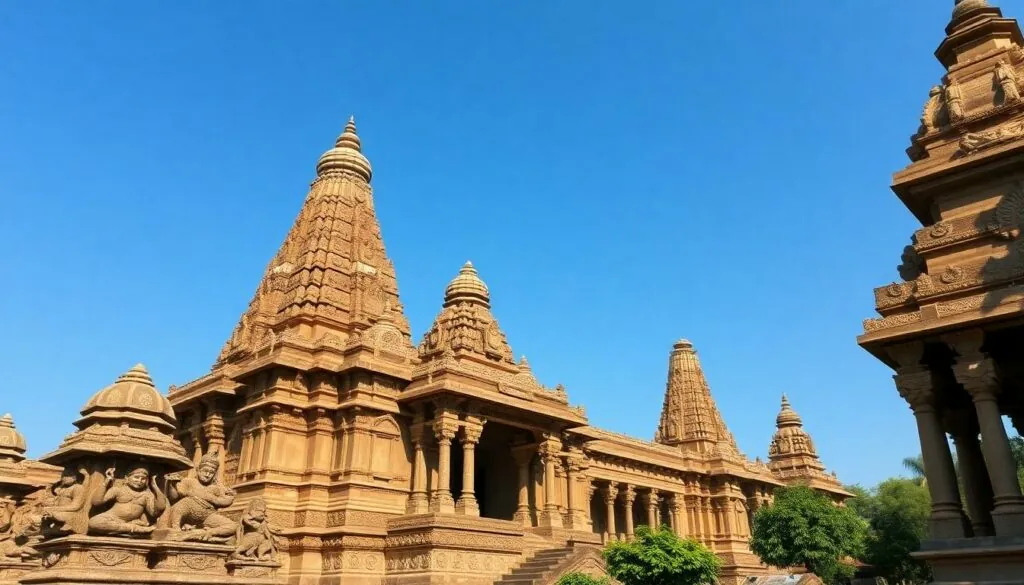Table of Contents
ToggleAncient Indian architecture isn’t just a feast for the eyes; it’s a time machine that whisks you back to the days of kings, queens, and a whole lot of intricate stonework. Imagine wandering through towering temples that whisper stories of devotion and grandeur or marveling at palaces that could make even the most modern skyscraper blush. This architectural wonderland is a testament to the creativity and craftsmanship of a civilization that knew how to build with style.
From the intricate carvings of Khajuraho to the majestic forts of Rajasthan, ancient Indian architecture offers a glimpse into a world where every stone has a story. It’s like a history book, but way cooler and with fewer footnotes. So buckle up as we explore the captivating structures that shaped India’s rich heritage and continue to inspire awe in visitors from around the globe.
Overview of Ancient Indian Architecture
Ancient Indian architecture showcases diverse styles influenced by various cultures and religions. Temples serve as prime examples, reflecting intricate designs that embody spiritual significance. The Dravidian style dominates the southern regions, characterized by towering spires and detailed sculpture work. Northern temples often display Nagara architecture, noted for their curvilinear shikharas.
Palaces constructed during different dynasties represent the power and sophistication of their eras. Amongst these, Rajasthan’s forts, such as Amer Fort and Mehrangarh Fort, highlight military architecture’s dimensions fused with artistic embellishments. Fortification features incorporate massive walls, intricate gates, and lookout towers, emphasizing the strategic significance of these structures.
In addition, cave architecture reflects an early understanding of excavation techniques. The Ajanta and Ellora caves exemplify remarkable rock-cut architecture, showcasing religious themes through elaborate carvings. These sites, with their ancient frescoes, offer insights into the artistic and cultural milieu of the period.
Ancient Indian architecture serves as a testament to the civilization’s architectural prowess. Structures stand not only as monuments but also as narratives encapsulating the essence of their time. Visitors can explore these architectural marvels across the Indian landscape, experiencing history through diverse styles and materials.
Key Features of Ancient Indian Architecture

Ancient Indian architecture shines through its distinct features, reflecting the cultural and religious diversity of the time.
Temple Architecture
Temple architecture displays intricate carvings and elaborate designs. Crafted with devotion, temples often feature towering shikhars that symbolize a connection to the divine. Notable examples include the Virupaksha Temple in Hampi and the Brihadeeswarar Temple in Thanjavur. Each temple incorporates various deities and mythological scenes within its stonework, showcasing the artistic skill of that era. Structures often utilize sandstone, granite, or limestone, which contributes to their longevity and beauty. Unique architectural styles, such as Dravidian and Nagara, reveal regional influences and the craftsmanship of ancient builders.
Fortress and Palace Architecture
Fortresses and palaces represent the grandeur of royal living. Defensive walls and elaborate gateways mark the entrances of famous forts like Mehrangarh and Amer. These structures highlight a blend of military and aesthetic design, illustrating the power of the rulers. Rooms adorned with frescoes and intricate jali work speak of luxury and artistic finesse. Additionally, courtyards and gardens add to the charm, offering spaces for leisure and social gatherings. Architectural elements, such as balconies and turrets, enhance functionality and visual appeal, making these structures critical components of ancient Indian heritage.
Regional Variations in Ancient Indian Architecture
Ancient Indian architecture showcases significant regional variations influenced by climate, culture, and available materials. Each region contributes unique styles reflecting the civilization’s architectural diversity.
North Indian Styles
Nagara architecture dominates North India, characterized by curvilinear shikharas. Temples such as the Kandaria Mahadeva Temple in Khajuraho exemplify this style with intricate sculptures and detailed carvings. Forts and palaces also feature prominently, showcasing a blend of military and artistic design. The Amer Fort and Mehrangarh Fort, for instance, highlight defensive features combined with opulent interiors, capturing the essence of royal life.
South Indian Styles
Dravidian style predominates in South India, known for towering gopurams and massive temples. The Brihadeeswarar Temple in Thanjavur exemplifies this grand architecture, complete with intricate frescoes and stone inscriptions. In addition, the temples often include spacious courtyards and pillared halls, offering a harmonious environment for worship. The design often symbolizes a connection to divinity, portraying various deities through elaborate sculptures.
Eastern and Western Influences
Trade and migration molded Eastern and Western architectural styles in India, introducing diverse influences. In the East, Odisha’s temples, such as the Jagannath Temple, are noted for their elaborate decoration and unique architectural forms. Conversely, Gujarat showcases Indo-Saracenic architecture in structures like the Sidi Sayyed Mosque, blending Islamic and Hindu elements. These regional influences reflect the cultural exchanges that shaped India’s architectural landscape over centuries.
Notable Examples of Ancient Indian Architecture
Ancient Indian architecture encompasses a variety of remarkable structures that showcase the ingenuity of their creators. Prominent examples include the Ajanta Caves and the Brihadeeswarar Temple, each representing unique architectural and artistic achievements.
The Ajanta Caves
The Ajanta Caves, located in Maharashtra, feature 30 rock-cut Buddhist caves dating from the 2nd century BCE to the 6th century CE. These caves boast exquisite frescoes and intricate sculptures that depict the life of Buddha. Unique narratives unfold through well-preserved paintings, illustrating various Jataka tales. Each cave serves a different purpose, such as monastic living quarters or prayer halls. Visually stunning, the caves still draw attention for their architectural precision and artistic detail.
The Brihadeeswarar Temple
The Brihadeeswarar Temple, situated in Thanjavur, exemplifies the grandeur of Dravidian architecture, constructed during the Chola dynasty in the 11th century. This UNESCO World Heritage Site features a towering vimana reaching 66 meters in height. Intricate carvings and stunning sculptures adorn its walls, showcasing the skill of ancient artisans. Devoted to Lord Shiva, the temple includes a massive stone Nandi statue weighing around 25 tons, emphasizing its religious significance. Enormous gopurams and elaborate frescoes enhance its architectural beauty, making it a pivotal cultural landmark.
Ancient Indian architecture is a remarkable testament to a civilization that thrived on creativity and craftsmanship. Its diverse styles and intricate designs not only showcase the artistic brilliance of the time but also reflect the rich cultural tapestry of India. Each structure tells a unique story, inviting exploration and admiration from those who seek to understand the past.
From towering temples to majestic forts the architectural legacy continues to inspire and educate. The fusion of various influences over centuries creates a captivating narrative that highlights the evolution of art and architecture in the region. As visitors walk through these historical sites they’re not just observing buildings but engaging with the enduring spirit of a vibrant culture.







